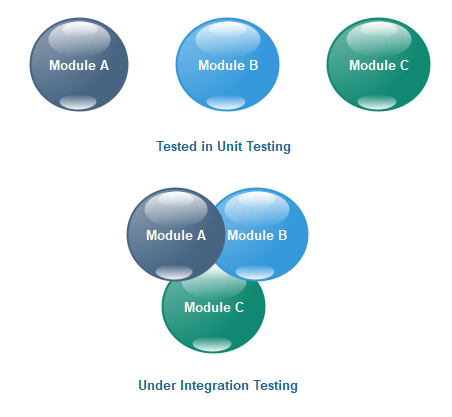Software performance can be evaluated by manual and automated testing, which aids in quality assurance. Integration testing examines how well multiple modules of a piece of software under development work together as a whole. Unit testing is typically undertaken by testers to verify the accuracy of specific units. The next stage is to integrate/combine them and test them as a single unit if everything is perfect separately, as a stand-alone unit.
Integration testing is crucial to ensuring that each component of a software program functions properly. Therefore, the effective integration testing results in developing a sound integration testing approach and comprehending the connections between modules within a single system and those that are part of external systems.
What is Integration Testing?
Integration testing is the second level of the software testing process comes after unit testing. Units or individual software components are tested collectively during this testing. The goal of the integration testing level is to identify flaws when integrated components or units interact. Modules are used in unit testing for testing purposes, and integration testing combines and tests these modules.
The software is created using a variety of software modules that were created by various programmers or coders. Moreover, integrity testing is done to ensure that all of the modules are communicating properly. Furthermore, integration testing is the process of verifying the data flow between dependent modules when each component or module is functioning independently.
What are the Advantages of Integration Testing?
Integration testing offers the software development process many beneficial benefits. This testing phase helps identify possible problems before they become more serious by looking at how multiple components work together as a whole.
Moreover, this testing reduces risks and improves the overall quality of the product by ensuring seamless interactions between various modules and systems. Additionally, initial detection and resolution increase cost-effectiveness because fixing issues during integration is less expensive than doing it later in the development cycle. The following are the benefits:
- Fault Detection: Integration testing assists in the early detection of faults by examining how components interact.
- Smooth Interaction: It guarantees fluid communication between various program components.
- Reduced Risks: Risks are reduced since issues are found early on, reducing the likelihood of catastrophic failures.
- Cost-Efficiency: Resolving problems early in the development process is less expensive than doing it later.
- Improved Quality: Interaction testing increases software’s overall quality and dependability.
Final Words
In conclusion, integration testing is an essential step in making certain that software components work together cohesively. In this complicated environment, Opkey’s testing automation platform becomes a crucial tool for streamlining the testing process. Its innovative features help to improve speed, efficiency and accuracy of the testing. The team can easily create, manage and execute automated tests with Opkey, saving the company’s costs and resources. It also simplifies the testing process by integrating easily with other tools like CI/CD and real-time monitoring solutions. Therefore, it’s a dependable option for automated integration testing that will help you achieve efficiency in the entire process.



